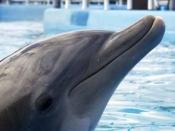SUMMARY OF INTRODUCTION
'This study investigated weather bottle-nosed dolphins could recall their own recent behaviors and reveal those recollections on the basis of an abstract (i.e. highly generalizable) rule. Two dolphins were trained to respond to a specific gesturual command by repeating the last behavior they performed. Unlike previous studies with other species, the behaviors the dolphins were asked to recall in this experiment included a substantial number of the dolphins' trained behaviors, as well as combinations of actions not explicitly trained and behaviors self selected by the dolphins. The tests of repeating performance were divided into four parts. Past experiments have only allowed researches to investigate whether animals could discriminate recently performed behaviors and perform arbitrary responses on the basis of those discriminations. This study requires that the dolphins not only discriminate but also identify past actions and perform responses that clearly reveal the extent to which those actions were identified.
The results of this study can potentially address more general questions about (1) the abilities of animals to represent their own recently performed behaviors in working memory, (2) the general accessibility of these representations, and (3) the ability of such representations to affect future behaviors.'
Does the Introduction Fit the Classic Structure?
The introduction went into detail concerning what is known about the abilities of animals to recall and identify their own actions. Several experiments which lead to those conclusions were also explained. It was then pointed out why those experiments and those conclusions were not sufficient to explain how or if animals were aware of their own actions. The introduction also explained the capabilities of dolphins which made them good subjects for this experiment. Overall the introduction was well laid out and it sufficiently explained the background of the subject and the questions that were to be addressed, as well as giving an overview of how the experiment was performed. This follows the traditional model of an introduction.
PROCEDURE
The experiment was divided up into four parts. The purpose of each part was described briefly. The general procedure for the experiment was presented in part A. This went into detail describing all general aspects of the procedure, such as describing the two dolphins used, the dimensions of the pool used, what the dolphins were fed, the preparation training that the dolphins under went, the gestural commands given to the dolphins, the location of the trainer and researchers in relation to the dolphin, the precautions that were taken to avoid inadvertent cuing of the dolphins, ect. The methods for each part of the experiment were explained separately. The procedure section adequately described how the experiment was conducted and contained the methods so that it could be reproduced. It did not however address the where and when portions of this experiment. A side note on the first page of the paper revealed that the research was done at the Kewalo Basin Marine Mammal Laboratory located in Honolulu Hawaii.
The results for each part of the experiment were presented and briefly discussed before the paper presented the methods of the next part of the experiment. Traditionally the results and discussion sections are entirely separate. However, it was appropriate in this paper because the results of each part lead up to the next part of the experiment. This allowed the paper to flow smoothly. The results were for each part of the experiment were combined and discussed in greater detail in a separate discussion in the paper.
SUMMARY OF PROCEDURES, AND RESULTS AND DISCUSSION
PART A
Methods:
In part A pretests were conducted in order to verify that the dolphins had a basic understanding of the repeating task and could perform the task within the constraints of the formal testing procedure. In addition, these pretests were used to identify a set of behaviors that were highly proficient at repeating, to serve as a baseline for comparison in later test trials.
Single gestural commands were used to instruct a dolphin to perform a single action, and multiple consecutive gestural commands were used to instruct a dolphin to perform several actions simultaneously, such as spitting while jumping. The repeat command consisted of a single gesture. This command was not associated with a specific action or actions as were the other commands, but rather it instructed the dolphin to repeat the behavior just performed. The dolphins were pretested on their ability to repeat several behaviors that were believed to be simple for them to repeat. Elele was tested in 5 sessions and Hiapo was tested in six sessions. Sessions consisted of 24 trials each. During the trials the trainer signaled the dolphin with the command corresponding to the first behavior (B1). After the behavior was performed a whistle was blown to signal the dolphin to terminate B1 and return to the training station. A gestural command corresponding to a second behavior (B2) was then given to the dolphin. This second command instructed the dolphin to either repeat the previous behavior (glossed as a repeat trial) or perform a specific behavior other than the initial behavior. If the dolphin had correctly performed B2 it was rewarded with praise and a fish.
Results and discussion:
Elele correctly performed 87% of the repeat trials. Hiapo did not do as well, performing 67% of the repeat trials correctly. During these trials four baseline behaviors that the dolphins repeated easily were identified. When tested with only these behaviors Elele correctly repeated commands in 100% of the trials, and Hiapo correctly repeated commands in 94% of the trials.
PART B
Methods:
In this portion of the experiment 8 test sets of increasing complex behaviors were used. The most difficult behaviors required that the dolphins perform several behaviors at once, such as jumping and spitting. These behaviors were signaled using combination gestures, consisting of up to 4 separate gestures to signal one behavior. A creative gesture the dolphins had previously been taught was also used in this test. The creative gesture is a single movement gesture. This gesture signals the dolphin to self-select a behavior. Any behavior can be given except those which have recently been given as a response to the creative command. A set of behaviors that the dolphins not previously been tested on were also included in this test. The dolphins had four opportunities to repeat each of the behaviors within the test.
Results and Discussion
In order for the dolphins' responses to be considered more than chance they had to correctly repeat behaviors 75% of the time. This number was chosen because the dolphins had four opportunities to repeat each behavior. Elele correctly repeated behaviors in 90% of the trials, and she correctly repeated every behavior at least once. Elele also performed correctly in 98% of non-repeat trials. Of the incorrect responses in non-repeat trials, only one was an unrequested repetition of the first behavior. Hiapo correctly repeated behaviors in 57% of the trials. He performed at above chance levels on 14 of the 32 test behaviors. He repeated 22 of the behaviors correctly at least once. Hiapo performed 90% of the non-repeat trials correctly. Only 3 of the 27 errors made between the two dolphins during non-repeat trials were unrequested repeats of the first behavior. This indicates that the
Elele correctly repeated three out of four self-selected creative behaviors, and Hiapo correctly repeated one of out four self-selected creative behaviors. Both Elele and Hiapo performed three different behaviors in response to the creative command. Because the creative command is not related to a specific behavior the dolphin's ability to repeat actions performed in response to this command strongly suggests that they are not simply recalling previous gestures.
The results clearly establish that both dolphins could repeat a variety of behaviors and self-selected behaviors. In addition, it is likely that, during these test sessions, the dolphins repeated many behaviors that they had never been asked to repeat before. However, because initial training sessions were not recorded in any detail, it is impossible to say with certainty which of the 32 behaviors the dolphins had previous experience repeating in informal sessions.
PART C
Methods:
Part C was conducted to clearly establish whether the dolphins had learned a generalized repeating rue, the dolphins were trained to perform four novel behaviors on first exposure.
The dolphins had experience performing behaviors similar to these; they had not been trained to perform stero-typed versions of these behaviors in response to specific gestural commands. Because these four behaviors were trained for use in this experiment, it is certain that the dolphins had no previous experience repeating them in response to the repeat command.
Results and Discussion
Both of the dolphins repeated each of the four novel behaviors correctly at least once out of their four opportunities. Elele correctly repeated novel behaviors in 79% of the trials, whereas Hiapo correctly repeated novel behavior in 50% of the trials. Elele performed at above chance levels on two of the four novel behaviors, and Hiapo performed at above chance levels on one of the four novel behaviors.
The responses that both Hiapo and Elele made in novel test trials may provide some insight into their strategies and repeating capabilities. For example, Elele seemed gradually to learn to recall the paddle behavior. The first time she was instructed to repeat this behavior she balked, the second time she repeated it correctly after hesitating, the third time she responded incorrectly but then when she was signaled to return to the trainer she swam over and performed the paddle behavior several times in succession before she finally returning. The fourth time Elele repeated the paddle behavior correctly without hesitation. Both Hiapo and Elele developed a similar encoding strategy for performing play ball. Normally in training sessions the dolphin would drop the ball and return to the training station after completing the behavior. In the context of the experiment, however, they quickly learned to keep the ball in their mouths, anticipating the possibility of a repeat command.
Overall the results provide compelling evidence that both dolphins learned a generalized repeating rule. Unlike two-alternative forced choice tasks that potentially allow the subjects to learn correct responses quickly using rules of exclusion and association, an incorrect response to the repeat command provides little information regarding what the correct response should have been. Consequently, performance in the first four exposures provides a stringent test of immediacy of transfer.
PART D
Methods:
The dolphins ability to repeat self-selected behaviors provides some evidence that they were recalling past behaviors rather than gestural commands. To further verify that the dolphins were recalling their past actions, Elele was tested on her ability to repeat behaviors multiple times on command. If the rule she had learned to follow when given a repeat command was repeat the behavior corresponding to the previous gesture, it would be difficult for her to respond correctly when the previous gesture was another repeat command. (Because this command was not associated with a specific behavior) However, if the rule she had learned was repeat the previous action, one would expect multiple repeat commands to be no more difficult than single repeat commands.
Two sessions were run in which Elele was presented with trials in which she was given two repeat commands in succession within a single trial. These test trials were conducted with only the four base line behaviors. A total of 16 trials were conducted (four with each baseline behavior). Elele had never been exposed to multiple consecutive repeat commands prior to these trials.
Results and Discussion
Elele performed 100% of the 16 double repeat trials correctly. She showed no hesitation in performing behaviors a third time when presented with two consecutive repeat commands. Her ceiling level performance indicates that she was recalling actions rather than gestures. In addition, her ability to immediately adapt to these novel trial types further demonstrates the flexibility with witch she could apply the repeating rule.
GENERAL DISCUSSION
Both Hiapo and Elele demonstrated the ability to perform the repeating task with a variety of behaviors of varying complexity. Elele successfully repeated every behavior she was tested on at least once. She repeated 26 of the 32 behaviors without error. In addition, both dolphins demonstrated that they had learned a generalized rule of repeating by correctly applying the repeating rule to novel behaviors. Both dolphins correctly repeated all four novel behaviors at least once in their first four exposures; Elele correctly repeated two novel behaviors without error, and Hiapo correctly repeated one novel behavior without error. This is the first finding of such abilities in any nonhuman species.
The paper goes on to discuss several different explanations for the results of the study, and explains how the results of the study show that the best of these explanations is that the dolphins were able to remember their actual behaviors, and then use that knowledge to perform certain tasks. For example it points out the possibility that the dolphins could have been remembering the gestures rather than the past actions they had performed. It is then pointed out that Elele was able to successfully repeat the first behavior twice in a row, and because the repeat command is not associated with a specific behavior, she would have been unable to do so by remembering only commands. After addressing several similar issues, the paper goes on to conclude that 'the simplest explanation that can account for all the results of the study is that dolphins can retain internal representations of their recent past actions in working memory and that they can use those to recreate past actions. Those representations must be flexibly accessible and detailed enough to allow for the repetition of fairly complex behaviors.' At the end of the discussion the paper points out the usefulness of these findings to the scientific world, saying that 'the repeating task provides a highly flexible way of investigating animals representations of past actions and events that can potentially be applied to a variety of species, it can also potentially increase our understanding of how animals represent their own actions. In particular, assessments of various species' ability to maintain and recall representations of recent actions can reveal the flexibility and specificity of animals' short term representations of those actions and can further elucidate the influence that internal and external factors have on animals' actions'. In general the discussion section fits the traditional format; however, some points such as identifying needed next steps in research on the problem are not clearly addressed.
Sources:
Capacity of bottle-nosed dolphins for generalization based on a relative sign, Neuroscience and Behavioral Physiology, Volume 21, Number 2 / March, 1991
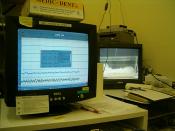
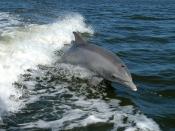
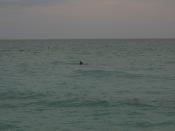
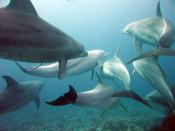
![[Behavior Body] Editorial Poses Series 2](https://s.writework.com/uploads/1/14647/behavior-body-editorial-poses-series-2-thumb.jpg)
